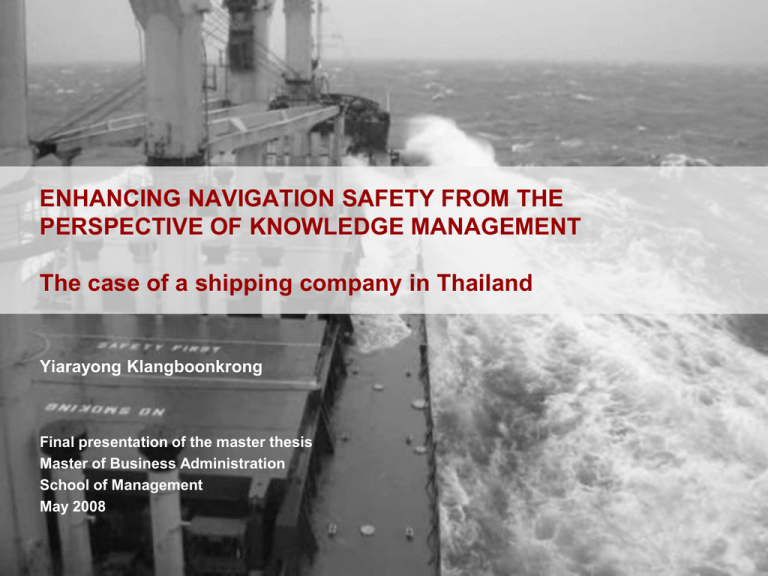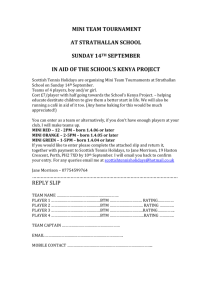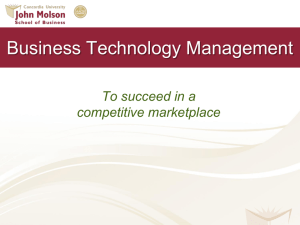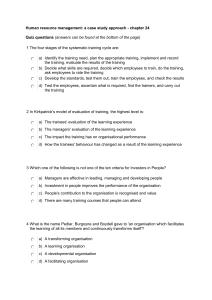to get the file
advertisement

ENHANCING NAVIGATION SAFETY FROM THE PERSPECTIVE OF KNOWLEDGE MANAGEMENT The case of a shipping company in Thailand Yiarayong Klangboonkrong Final presentation of the master thesis Master of Business Administration School of Management May 2008 Agenda I. Introduction II. Literature review III. Research framework and methodology IV. The case organisation V. Discussion VI. Conclusion and recommendations Slide 2 The research was conducted as an inquiry into a contemporary phenomenon in a shipping company Rationale Aims and objectives • Shipping regarded as the most internationally recognised and the most dangerous industry • Common acceptance of human element as the most important factor contributing to maritime safety – reportedly 80% of maritime casualties resulted from human error • Training as the widely suggested means of improving human element • Possible opportunities for improvement using KM concepts Scope of the research Slide 3 The research aimed to find solutions feasible for a realworld company in an academically-sound manner Rationale Aims and objectives Scope of the research • Investigate the current situation of the case organisation • Examine gaps and unexploited opportunities in managing knowledge gained from experiences and practices • Suggest possible solutions specific to the company, taking into consideration its special characteristics • Propose illustrative framework of resources and processes in KM derived from the empirical situation Slide 4 The research focused on a particular area of knowledge in a single company Rationale • Research focus was placed on how the company deals with knowledge in Bridge Team Management (BTM) for the purpose of improving navigation safety performance • Single case study conducted in one shipping organisation Aims and objectives Scope of the research Slide 5 Agenda I. Introduction II. Literature review III. Research framework and methodology IV. The case organisation V. Discussion VI. Conclusion and recommendations Slide 6 Concepts relevant to the empirical situation have been reviewed Knowledge as a strategic asset Knowledge management (KM) and organisational learning (OL) Enhancing navigation safety Dealing with different types of knowledge Safety in the maritime industry Slide 7 Organisational knowledge is widely accepted as the only source of competitive advantage • Organisational knowledge is valuable, rare, inimitable, and nonsubstitutable (Bollinger and Smith, 2001). • Bou-Llusar and Ciprés (2006) identified internal knowledge transfer as crucial for managing strategic knowledge. • Organisational learning plays a central role in generating the competitive advantage (Pemberton and Stonehouse, 2000). • A strong organisational culture and organisation learning are sources of sustainable competitive advantage (Martín-de-Castro et al., 2006) . Slide 8 KM plays a role of providing “the methods and tools to build up the intelligence of the system required to reach the business objective” (Border, 2006). Organisational memory Application of knowledge Organisational learning Creation of knowledge Innovation Source: Diakoulakis et al. (2004) Slide 9 Core processes of KM should be holistically considered in concert Knowledge goals Knowledge assessment Knowledge identification Knowledge retention Knowledge acquisition Knowledge utilisation Knowledge development Source: Probst et al. (2000) Knowledge sharing/distribution Slide 10 Recent literature suggests that OL and KM are complementary • KM is a directive process involving deliberate interventions whereas OL attributes to changes in the organisational knowledge base (Probst et al., 2000). • OL assumes knowledge as an inevitable result of learning but not as the focus of the concept (McElroy, 2000). • Knowledge creation is the main linkage of OL and KM, for knowledge generated by OL should be systematically managed by KM (Loermans, 2002). Slide 11 Knowledge exists in two basic forms – explicit and tacit • Explicit knowledge is relatively easy to be codified and shared. It is related to established and organised work processes (Heath, 2003). • Tacit knowledge is experiential and less susceptible to codification and sharing. Also regarded as “know-how,” it is acquired through experience and often resembles intuition (Heath, 2003). Slide 12 There exist different opinions on how tacit knowledge should be managed • A number of commentators argue that tacit knowledge needs to be codified for others to understand (e.g. Border (2006)) whereas others argue that tacit knowledge is best shared by personal interactions (Lang, 2001; Kreiner, 2002). • Lang (2001) argue that complete explication may reduce the resourcefulness and the strategic value of knowledge. • In case of knowledge codification, it is necessary to know the potential users and their purposes of using knowledge (Hall, 2006). • Not only knowledge has to be understood, learning involves absorbing new perspectives, practices, logic, and common wisdom of causal relationships mutually shared by practitioners or member of a community (Lang, 2001). Slide 13 Workplace learning often occurs informally, hence the importance of informal learning • Formal education and experience should be complementary (Paloniemi, 2006). • Experience may have both positive and negative implications on a worker’s learning motivation (Paloniemi, 2006). • Social participation is a key to experience-based learning (MacNeil, 2004; Paloniemi, 2006). Formal learning Learning by reflection Informal learning Theoretical knowledge Competence Practical knowledge Source: Svensson et al. (2004) Slide 14 Communities of Practice (CoPs) is a concept believed to be capable of preserving tacit knowledge in a living form • A CoP is “a group of people who share a concern, a set of problems, or a passion about a topic, and who deepen their knowledge and expertise in this area by interacting on an ongoing basis” (Wenger et al., 2002). • Basic elements of a CoP consist of a community, a domain of knowledge, and a shared practice (Wenger, 1998). • The issue of whether a CoP has to be “emergent” or able to be “managed” has remained controversial among commentators (Pemberton et al., 2007). • A CoP may help address the problems associated with managed learning (Mittendorff et al., 2006). Slide 15 Management commitment, employee’s involvement, and safety management system are key dimensions of the safety culture • “Safety culture is the enduring value and priority placed on worker and public safety by everyone in every group at every level of an organisation” (Zhang et al., 2000) • Safety culture plays an important role even in the presence of a safety management system (Kenney and Kirwan, 1998). • The importance of management influence is widely accepted. In the shipping industry, however, the employees are almost constantly detached from shore managers, hence the implications on safety performance (Ellis, 2005). Slide 16 Issues derived from the literature review • The strategic value of organisational knowledge and OL as a means of achieving competitive advantage • Complementary properties of OL and KM • Strategic properties of tacit knowledge and implications on knowledge sharing • Contributions of workplace learning to managing tacit knowledge • Importance of safety culture and management commitment and safety performance Slide 17 Agenda I. Introduction II. Literature review III. Research framework and methodology IV. The case organisation V. Discussion VI. Conclusion and recommendations Slide 18 Research framework Corporate characteristics/constraints Corporate culture Safety culture Critical knowledge asset identification Implications of knowledge content/disparity on sharing/distribution process Critical knowledge asset classification Tacit knowledge Critical knowledge asset Bridge Team Management (BTM) - Passage appraisal, planning, execution and monitoring - The bridge organisation and teamwork - Pilotage - Communication - Ship handling - Electronic navigation Tacit or explicit? - Passage appraisal, planning, execution and monitoring - The bridge organisation and teamwork - Pilotage - Communication Explicit knowledge - Passage appraisal, planning, execution and monitoring - Ship handling - Electronic navigation Knowledge disparity Senior deck officers Interactive, collective, and experience-based learning Possible concepts: communities, forums Mentoring held by target users Target users Feedback Junior deck officers Prescriptive learning and reflection of others’ past experiences Possible concepts: training, mentoring All deck officers Formal, classroom-format training and simulation Safer navigation Proper implementation and development of bridge team procedures Slide 19 Concepts from literature and empirical findings led to research framework and propositions Research propositions 1. The tacit dimension of a certain knowledge asset, given its nature of content and condition of utilisation, has to be managed differently from its explicit counterpart. 2. Disparity in knowledge held by knowledge users has to be taken into account when considering interventions, especially when targeting tacit knowledge. Slide 20 Case study method was used, as the research is based on the realism paradigm • A paradigm is a basic belief system spanning across ontology, epistemology, and methodology. – Realism assumes an external reality though not fully apprehensible – Subjective perceptions lead to the reality which exists independently of such perceptions. Reality is arrived at by triangulation. – Contextual contingency – Appropriate for “how” and “why” questions • Case study is “a research strategy which focuses on understanding the dynamics present within single settings” (Amaratunga and Baldry, 2001). – Case study is helpful for handling complex social phenomena in which underlying mechanisms and factors are not easily correlated. Slide 21 Validity and reliability has to be assured in a case study research Criteria Description of criteria Case study techniques Ontology 1. Ontological appropriateness Research problem dealing with complex social science phenomena involving reflective people Selection of a research problem, for example, it is a how and why problem 2. Contingent validity A system involving generative mechanisms rather than direct cause-and-effect Theoretical and literal replication, in-depth questions, emphasis on "why" issues, description of the context of the cases Neither value-free nor value-laden, rather value-aware Multiple interviews, supporting evidence, broad questions before probes, triangulation. Self-description and awareness of own values. Published reports for peer review. 4. Methodological trustworthiness Trustworthy - the research can be audited Case study database, use in the report of relevant quotations and matrices that summarise data, and of descriptionsof procedures like case selection and interview procedures 5. Analytic generalisation Analytic generalisation (that is, theory building) rather than statistical generalisation (that is, theory-testing) Identify research issues before data collection, to formulate an interview protocol that will provide data for confirming or disconfirming theory 6. Construct validity (n/a) Use of prior theory, case study database, triangulation Epistemology 3. Multiple perceptions of participants (and of peer researchers) Methodology Source: edited from Healy and Perry (2000) Slide 22 Case study protocol was developed accordingly • Interview participants – Members of shore-based management (middle managers, superintendent, operational staff) – Five senior deck officers (Master and Chief Officers) • Interview questions – Unstructured (for shore staff) and semi-structured (for sea staff) • Data analysis – Based on theoretical propositions – Empirical pattern compared with a predicted one, i.e. that stated in the proposition • Limitations – Single case Slide 23 Agenda I. Introduction II. Literature review III. Research framework and methodology IV. The case organisation V. Discussion VI. Conclusion and recommendations Slide 24 The shipboard organisation MASTER • DECK DEPARTMENT ENGINE DEPARTMENT CHIEF OFFICER CHIEF ENGR. SECOND OFFICER SECOND ENGR. THIRD OFFICER THIRD ENGR. CHIEF COOK BOSUN FOURTH ENGR. MESSMAN DECK FITTER ELECTRICAL ENGR. ABs ASST. ELEC. ENGR. DECK BOYS ENG. FITTER – – – • OILERS ENGINE BOYS Employment nature Ship-to-shore connections – – • Contractual Usually 9 months/contract Important role of personal relationships Satellite connection Physical contact possible in ports Characteristics of a shipping company – – – – Fundamentally mobile workers Volatile job markets High uncertainty of teamwork compositions Limited presence of IT facilities on board vessels Slide 25 Some of the company’s activities are directed to improving the knowledge of seafarers • Physical presence is required for most activities and remains a very important concern for coordination. • Activities include – In-house and public training in classroom-format – E-learning – On board training by training superintendents – Lessons learned and good practices – Temporary employment of an officer – Intensive training and workshop for the promotion of deck officers • Measurements of training mostly is done quantitatively and based more on inputs (e.g. number of officers trained each year). • Training perceived as “good to have” but not always “relevant” Slide 26 Bridge Team Management (BTM) is identified as the critical knowledge • Collisions have contributed to the largest proportion of the company’s major claims. The company’s incident rate is slightly above the industry’s average. • None of the company’s collisions was related to equipment malfunctions. • From past incidents, the causes identified include ambiguous communication, improper watchkeeping, commercial pressure, inadequate experience, fatigue, and negligence. • The management treat BTM as a high priority. The policy recently issued states: – BTM training course is to be prescribed to every deck officers – Each officer is required repeat the training yearly during his leave between contracts Slide 27 BTM training course is conducted in classroom format with simulation modules • BTM is equivalent to Crew Resource Management (CRM) in aviation • BTM course introduces the concept of a navigation team to ship masters and watch officers and frames their decision making process toward establishing watch conditions during the voyage (Conrad, 2007). • BTM course is designed to minimise the risks of incidents by encouraging safe behaviour. • BTM modules include passage planning, ship handling, electronic navigation, bridge organisation, teamwork, pilotage, communication. • For some commentators, direct training is considered less usual than informal learning (Swift, 2000) Slide 28 Deck officers trained in a BTM course showed similar opinion towards BTM training Necessity of training • In general, respondents expressed a positive attitude toward training. The training method • Experience was perceived as crucial for task executions and safety but experience by itself does not guarantee desired outcomes. Management policy on BTM training “… people most prone to accidents are either veterans or rookies.” • Respondents regarded soft skills as needing more improvement than technical skills. • No affirmation of training being perceived as the appropriate means of improvement. Slide 29 Deck officers trained in a BTM course showed similar opinion towards BTM training Necessity of training The training method • Respondents regard technical component of the BTM course as basic. They regard “soft” aspects as needing improvement. • One respondent advocated seminars, discussions, and workshops. “That’s how you can use your own experience to learn things.” Management policy on BTM training • Combining junior and senior officers may help in mentoring but pose difficulty in class training. • Willingness to learn is doubtful. Respondents suggested that the relevance of a training course be demonstrated. Slide 30 Deck officers trained in a BTM course showed similar opinion towards BTM training Necessity of training • The management has announced its policy on BTM training that every deck officer has to attend a training course on a yearly basis in order to serve on another vessel. • BTM training is well-accepted among the respondents but none agreed with the requirement for yearly attendance. The training method Management policy on BTM training (1/2) “One time training is good. More than that is too boring for us and too expensive for the company.” “After the first training, further improvement should be more customised.” Slide 31 Deck officers trained in a BTM course showed similar opinion towards BTM training Necessity of training • Respondents pointed to the actual work condition as having a significant impact. “I suspect that it will be just as bad as it is if they invest a lot in training but continue to be cheap on supplies to the ship.” The training method • Management policy on BTM training (2/2) Issue of “susceptibility to training:” There is little belief that the training is an effective agent for promoting change. Respondents preferred the other way around. “We are training a lot of people who are not ready for it.” • A mere training was seen as an overly simplistic approach to developing seafarers. Slide 32 Agenda I. Introduction II. Literature review III. Research framework and methodology IV. The case organisation V. Discussion VI. Conclusion and recommendations Slide 33 P1: The tacit dimension of a certain knowledge asset has to be managed differently from its counterpart (1/2) • Empirical finding suggests that the intervention for managing tacit knowledge should take into account a) the nature of knowledge content b) the condition of knowledge utilisation. Knowledge distribution method Classroom training Method suitable for the sharing of BTM knowledge Nature of knowledge content Condition of utilisation Informative, explicit, and technical Accuracy in understanding and execution in a context where prohibitive condition is insignificant Intuitive, tacit, social Collective tasks in the presence of prohibitive and complex conditions, e.g. commercial pressure and lack of operational support Slide 34 P1: The tacit dimension of a certain knowledge asset has to be managed differently from its counterpart (2/2) Nature of knowledge content • • • Experiential Involves complex interplay of technical, commercial, human, and organisational factors To be accompanied by attitude Implications for managing BTM knowledge • • • Condition of knowledge utilisation • • • Tasks delivered collectively Presence of prohibitive conditions (commercial pressures, lack of operational support, etc.) Operating in locations remote from the management • Collective learning necessary Training requiring accompanying measures Social measures unique to an organisation needed The same subjective norms and ideals to be shared by management and seafarers Slide 35 P2: Disparity in knowledge held by knowledge users has to be taken into account when considering interventions Visualising knowledge transparency Recognising knowledge disparity Visualising transparency and recognising disparity helps a practitioner: • • • Find out what knowledge assets locate with whom Configure the delivery of new knowledge, either formally or informally, to the pool of knowledge users Benefit from those with relatively larger knowledge repertoire e.g. by mentoring Note: Knowledge disparity among deck officers of the same rank is highly subtle. Knowledge transparency is an organisation’s ability to maintain the overall picture of its knowledge asset (Probst et al., 2000). Slide 36 Issues raised by the two propositions are preconditions of collective knowledge building Interaction/communication Transparency Building collective knowledge Integration Preconditions identified by Probst et al. (2000) Slide 37 Recommendations for the case organisation • Securing consistency in implicit and explicit communications and shaping appropriate context for using knowledge • Establishing knowledge goal(s) • Achieving adequate knowledge transparency • Collective learning for complementing one-way knowledge distribution • Utilising own past experiences Slide 38 Agenda I. Introduction II. Literature review III. Research framework and methodology IV. The case organisation V. Discussion VI. Conclusion and recommendations Slide 39 The research has led to the conclusion of managing non-technical knowledge for navigation safety • This single-case study research focused on bridge team management (BTM) due to its significant impact on navigation safety of the case organisation. Its entire spectrum of knowledge, both technical and non-technical, has been addressed through formal training. • Important concerns raised by respondents involve the susceptibility to learning and working condition. • Propositions have been made with regards of – The nature of knowledge content – The condition of knowledge utilisation – Knowledge transparency and disparity • Suggestions have been made based largely on the above dimensions. Slide 40 Several concepts should be further studied for understanding maritime safety and KM in shipping • Safety culture and learning organisation – How safety culture and organisational learning impact each other? • Safety management and knowledge management – How safety management and knowledge management impact each other? – How does an organisation develop mutual processes to benefit from both constructs? • IT for KM in the shipping industry – How to develop an IT system appropriate for addressing the constraints present in a shipping organisation? • Subjective norms of seafaring communities – How do subjective norms shared by seafaring communities of a certain national culture impact the culture and the safety performance of a shipping organisation? Slide 41 Thank you Slide 42





